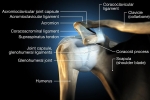SLAP Tears: Current Treatment

First, what is a SLAP tear?
A SLAP lesion is a tear of the superior glenoid labrum extending from anterior to posterior. There are two predominant mechanisms of injury. First is a compressive force, typically a fall onto an outstretched arm with the shoulder in abduction and slight flexion. The second, and more common mechanism, is repetitive traction on the arm. The anterosuperior labrum is the anchor for the long head of biceps tendon and repetitive loading of the biceps tendon is thought to precipitate superior labrum injuries. In throwing athletes in particular, the long head of biceps tendon acts as a decelerator during ball release. The biceps also propagates torsional forces through the labrum during the cocking phase of maximum abduction and external rotation, known as the “peel back” mechanism.
Classification of SLAP tears was originally described by Snyder, organizing tears into four different types. That classification system has now expanded to include 10 different types of SLAP tears.
In brief, a Type I SLAP tear is simple fraying, no detachment. A Type II tear is the most common type and involves detachment of the long head of biceps tendon. A Type III tear is a bucket handle tear of the labrum with an intact biceps anchor. A Type IV tear is a bucket handle tear that extends into the biceps anchor attachment.
Treatment of all SLAP tears starts with non-op management including rest, physical therapy, possible intraarticular injections including corticosteroid (more for middle-aged individuals) and biologics like PRP, though data on that is limited.
Surgery is reserved for patients who fail conservative treatment. Surgical treatment of SLAP tears includes debridement, repair, biceps tenodesis and biceps tenotomy. More recently, there has been a shift towards the selection of biceps tenodesis, but SLAP repair remains the most common procedure in young throwing athletes – for now.
Brian Waterman and Tony Romeo published a case series in the January 2023 issue of Arthroscopy titled “High Rate of Return to Sporting Activity Among Overhead Athletes with Subpectoral Biceps Tenodesis for Type II SLAP Tear”. The authors reported that 81% of patients returned to their previous level of play at an average of 4 months post-op. There were also significant improvements in VAS and SANE scores post-op.
But how do repairs do in this population? The answer is… not great. Return to preinjury level of play after SLAP repair has been reported in the range of 54% to 63% of elite throwers. In one cohort study by Boileau, 60% of patients reported persistent shoulder pain after SLAP repair and 50% elected to undergo secondary surgery.
Provencher published on his outcomes of SLAP repair in an active military population and reported a 37% failure rate and 28% revision rate at short to mid-term follow up.
Another article focuses technique and is titled “No Difference in Clinical Outcomes for Arthroscopic Suprapectoral Versus Open Subpectoral Biceps Tenodesis at Midterm Follow-up.” Nikhil Verma and colleagues at Rush compared arthroscopic suprapectoral tenodesis versus open subpectoral tenodesis for long head of biceps tendon disease, so not SLAP tears. They reported no significant differences in patient reported outcomes or complications at any time point.



